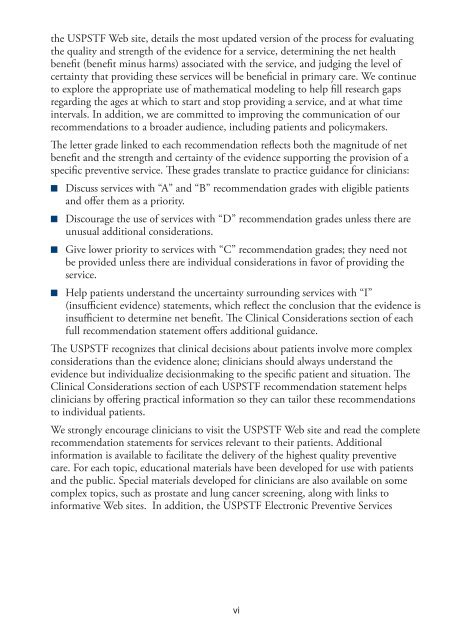1DpwC8F
1DpwC8F
1DpwC8F
Create successful ePaper yourself
Turn your PDF publications into a flip-book with our unique Google optimized e-Paper software.
the USPSTF Web site, details the most updated version of the process for evaluating<br />
the quality and strength of the evidence for a service, determining the net health<br />
benefit (benefit minus harms) associated with the service, and judging the level of<br />
certainty that providing these services will be beneficial in primary care. We continue<br />
to explore the appropriate use of mathematical modeling to help fill research gaps<br />
regarding the ages at which to start and stop providing a service, and at what time<br />
intervals. In addition, we are committed to improving the communication of our<br />
recommendations to a broader audience, including patients and policymakers.<br />
The letter grade linked to each recommendation reflects both the magnitude of net<br />
benefit and the strength and certainty of the evidence supporting the provision of a<br />
specific preventive service. These grades translate to practice guidance for clinicians:<br />
■■<br />
■■<br />
■■<br />
■■<br />
Discuss services with “A” and “B” recommendation grades with eligible patients<br />
and offer them as a priority.<br />
Discourage the use of services with “D” recommendation grades unless there are<br />
unusual additional considerations.<br />
Give lower priority to services with “C” recommendation grades; they need not<br />
be provided unless there are individual considerations in favor of providing the<br />
service.<br />
Help patients understand the uncertainty surrounding services with “I”<br />
(insufficient evidence) statements, which reflect the conclusion that the evidence is<br />
insufficient to determine net benefit. The Clinical Considerations section of each<br />
full recommendation statement offers additional guidance.<br />
The USPSTF recognizes that clinical decisions about patients involve more complex<br />
considerations than the evidence alone; clinicians should always understand the<br />
evidence but individualize decisionmaking to the specific patient and situation. The<br />
Clinical Considerations section of each USPSTF recommendation statement helps<br />
clinicians by offering practical information so they can tailor these recommendations<br />
to individual patients.<br />
We strongly encourage clinicians to visit the USPSTF Web site and read the complete<br />
recommendation statements for services relevant to their patients. Additional<br />
information is available to facilitate the delivery of the highest quality preventive<br />
care. For each topic, educational materials have been developed for use with patients<br />
and the public. Special materials developed for clinicians are also available on some<br />
complex topics, such as prostate and lung cancer screening, along with links to<br />
informative Web sites. In addition, the USPSTF Electronic Preventive Services<br />
vi


